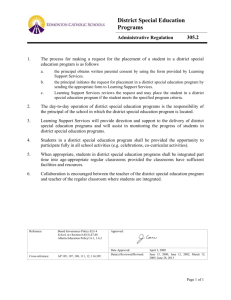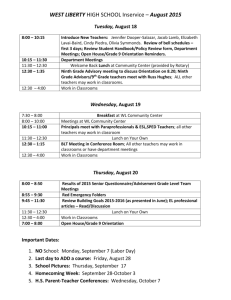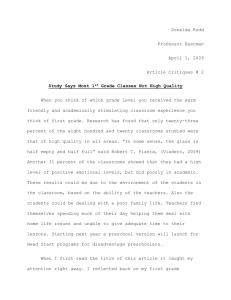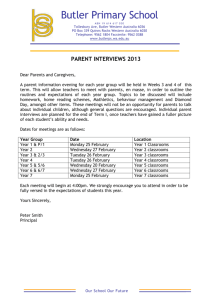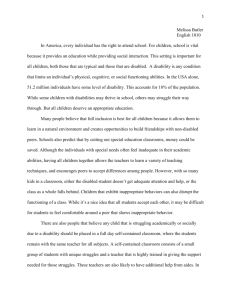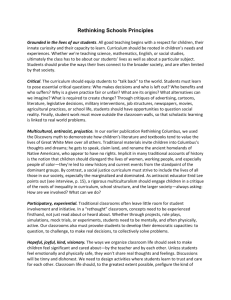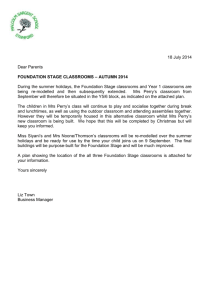FR 1-8 12/11 Abstract Taking a Closer Look at the Impact of
advertisement
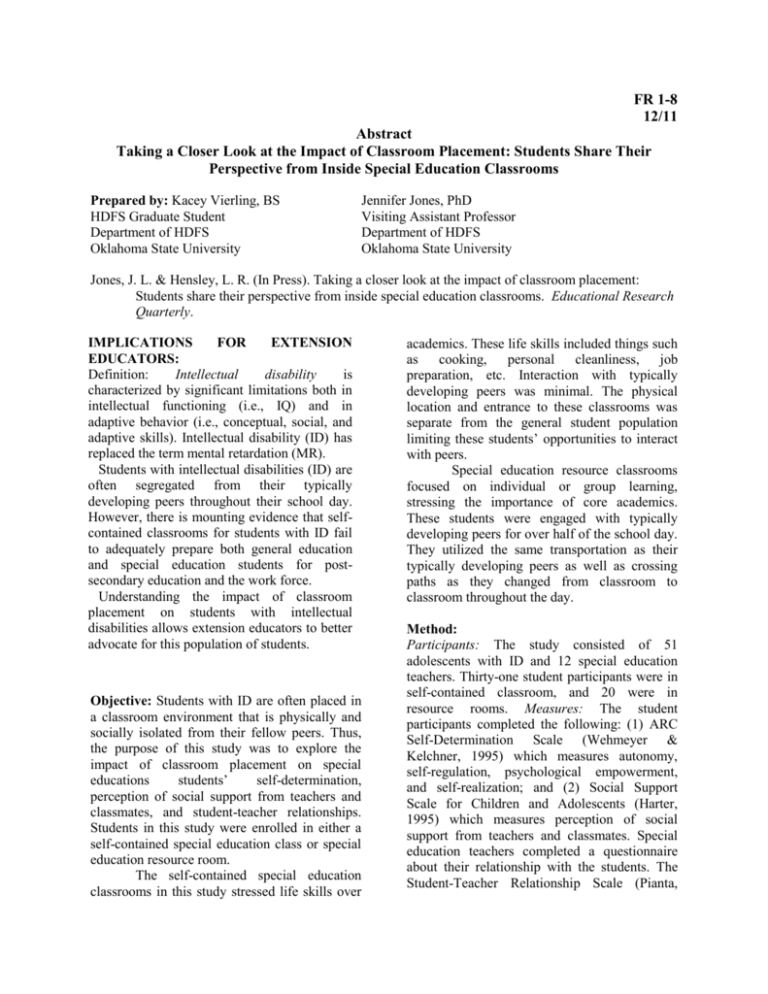
FR 1-8 12/11 Abstract Taking a Closer Look at the Impact of Classroom Placement: Students Share Their Perspective from Inside Special Education Classrooms Prepared by: Kacey Vierling, BS HDFS Graduate Student Department of HDFS Oklahoma State University Jennifer Jones, PhD Visiting Assistant Professor Department of HDFS Oklahoma State University Jones, J. L. & Hensley, L. R. (In Press). Taking a closer look at the impact of classroom placement: Students share their perspective from inside special education classrooms. Educational Research Quarterly. IMPLICATIONS FOR EXTENSION EDUCATORS: Definition: Intellectual disability is characterized by significant limitations both in intellectual functioning (i.e., IQ) and in adaptive behavior (i.e., conceptual, social, and adaptive skills). Intellectual disability (ID) has replaced the term mental retardation (MR). Students with intellectual disabilities (ID) are often segregated from their typically developing peers throughout their school day. However, there is mounting evidence that selfcontained classrooms for students with ID fail to adequately prepare both general education and special education students for postsecondary education and the work force. Understanding the impact of classroom placement on students with intellectual disabilities allows extension educators to better advocate for this population of students. Objective: Students with ID are often placed in a classroom environment that is physically and socially isolated from their fellow peers. Thus, the purpose of this study was to explore the impact of classroom placement on special educations students’ self-determination, perception of social support from teachers and classmates, and student-teacher relationships. Students in this study were enrolled in either a self-contained special education class or special education resource room. The self-contained special education classrooms in this study stressed life skills over academics. These life skills included things such as cooking, personal cleanliness, job preparation, etc. Interaction with typically developing peers was minimal. The physical location and entrance to these classrooms was separate from the general student population limiting these students’ opportunities to interact with peers. Special education resource classrooms focused on individual or group learning, stressing the importance of core academics. These students were engaged with typically developing peers for over half of the school day. They utilized the same transportation as their typically developing peers as well as crossing paths as they changed from classroom to classroom throughout the day. Method: Participants: The study consisted of 51 adolescents with ID and 12 special education teachers. Thirty-one student participants were in self-contained classroom, and 20 were in resource rooms. Measures: The student participants completed the following: (1) ARC Self-Determination Scale (Wehmeyer & Kelchner, 1995) which measures autonomy, self-regulation, psychological empowerment, and self-realization; and (2) Social Support Scale for Children and Adolescents (Harter, 1995) which measures perception of social support from teachers and classmates. Special education teachers completed a questionnaire about their relationship with the students. The Student-Teacher Relationship Scale (Pianta, 2001) measures student-teacher relationship patterns in terms of conflict, closeness, and dependency, as well as the overall quality of the relationship. Results: Overall, more positive student outcomes were associated with the students enrolled in resource classrooms compared to students in self-contained classrooms. The study results show that special education students in resource rooms report greater feelings of selfdetermination than their peers in self-contained classrooms. Special education teachers of students in resource rooms also reported more favorable patterns of student-teacher relationship (i.e., less conflict, more closeness, and lower dependency) than did their colleagues who taught in self-contained classrooms. Implications: Interaction with typically developing peers significantly influences the development of self-determination. Selfdetermination can be defined as “the combination of skills, knowledge, and beliefs that allow an individual to take part in goaloriented, self-regulated, autonomous behavior” (Field, Martin, Miller, Ward, & Wehmeyer, 1998, p. 2). Research supports a strong association between self-determination and multiple positive outcomes for students with ID. For example, when self-determination is developed, students with ID are more successful in life transitions (e.g. adulthood, employment, gaining independence). “Teaching self-determination directly and systematically involves offering learners choices and soliciting their preferences within social and educational contexts, helping them develop self-advocacy skills, promoting selfesteem, providing attribution training, and providing access to positive role models who exhibit self-determined behavior themselves” (Angell, Stoner, & Fulk, 2010, p. 66). Hence it is important to think about when student socialization occurs in middle school and high school buildings during the school day and how the physical location of the special education classroom factors into these naturally occurring opportunities to interact with the general school population. Three specific times during the school day in which socialization inevitably occurs for students and in which socialization does not serve to distract from the delivery of academic education include: passing periods, lunch, and school sponsored clubs and activities. Conclusion: This study found that students with ID in self-contained classrooms reported lower self-determination than their peers with ID in resource rooms. Findings also indicate that teachers perceived students in self-contained classrooms as more dependent than their peers with ID in resource rooms. Several practical strategies for improving outcomes and relationships for these students are offered by the authors. For students to build selfdetermination skills, they must be given opportunities to make choices about their school day and have access to positive role models who also exhibit self-determined behaviors. Students have greater opportunities to engage in positive relationships when they have access to their school’s natural social environments: including hallway conversations, lunchtime, and school sponsored clubs and activities.

